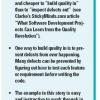|
|
Know Where Your Wheels Are Drawing from his experiences while learning to drive, Michael applies lessons he learned from written rules, experiential learning, and the advice of mentors to teaching new testers some valuable skills.
|
|
|
|
Out of the Rut Are you bored? Do feel as if all you do is repeat heavily scripted tests and as a result you aren't learning, discovering new problems, or finding bugs? These nine heuristics can help you get out of your rut and take back control of your testing process.
|
|
|
|
Learning the Hardware Lessons Systems and software aren't just about correctness; they are also about solving problems for people. According to the context-driven software testing movement, a problem isn't solved if the product doesn't work. Michael's experience in a hardware store drives that lesson home.
|
|
|
|
How Much Is Enough?—Exploring Exploratory Software Testing Exploratory testers design and execute tests in the moment, starting with an open mission and investigating new ideas as they arise. But how do we know when to stop? The first step is to recognize that we can't know when we're done, because any approach to answering the stopping question is necessarily heuristic.
|
|
|
|
What Counts? In the testing business, we are infected with counting disease–we count test cases, requirements, lines of code, and bugs. But all this counting is an endemic means of deception in the testing business. How do we know what numbers are truly meaningful?
|
|
|
|
A Story About User Stories and Test-Driven Development: The Setup While "testing" is part of its name, many TDD pundits insist TDD is not a testing technique, but rather a technique that helps to focus one's design thinking. Drawing on real events from the authors' combined experience, this story follows a fictional team as it encounters some of the pitfalls of using test-driven development.
|
|
|
|
Behind the Scenes Have you ever found a major defect while testing an unfamiliar system and been unable to explain exactly how you found it? The Framework for Exploratory Testing can help. These four activities help you explain your thought processes and allow you to train others to be better exploratory testers.
|
|
|
|
How Testers Think People think in models and metaphors, which help us make sense of the world and deal with new things. Citing material from the book "How Doctors Think", Michael draws a comparison between how doctors diagnose illness in patients and how testers find problems in software.
|
|
|
|
Users We Don't Like Mom always said, "If you can't say something nice, don't say anything at all." But Michael Bolton made an interesting discovery when he asked testers to talk about users they don't like. While nobody likes a complainer, listening to what your users are saying--even if you don't like it--can help you spot problems you may have overlooked.
|
|
 |
Getting Your Hands Dirty One way to build quality in is to prevent defects from ever happening. Discover how you can avoid defects by figuring out how to test each feature or requirement before you begin to write the code. Clarke Ching offers up an easy, hands-on example you can put to use today.
|
|

